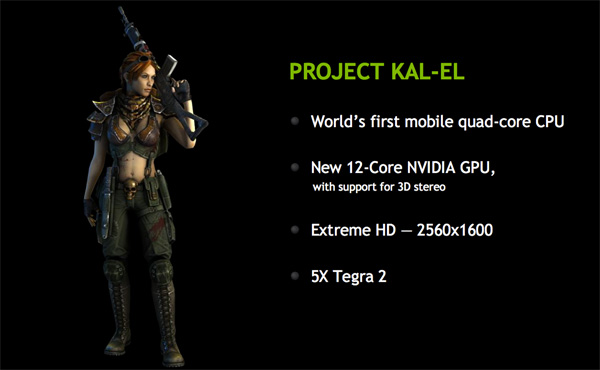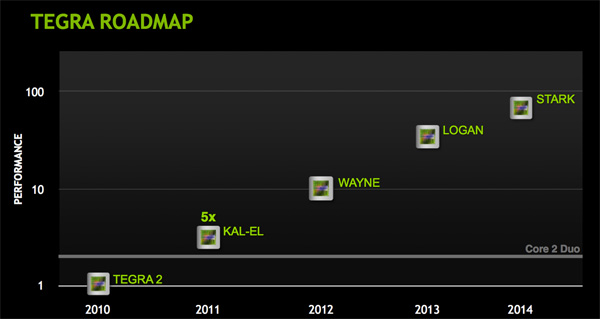NVIDIA's Project Kal-El: Quad-Core A9s Coming to Smartphones/Tablets This Year
by Anand Lal Shimpi on February 15, 2011 9:05 PM ESTIf there's any one takeaway from both CES and Mobile World Congress this year it's that NVIDIA is unequivocally a player in the SoC space. With design wins from LG, Motorola and Samsung, NVIDIA may not have the entire market but it has enough of it to be taken seriously.
In our Optimus 2X Review I mentioned that it looked like NVIDIA was going to be moving to a 6-month product cycle in the SoC space. The intention is to out execute its competitors frequently enough that they are either forced out of the market or into making a mistake trying to keep up. It's the same strategy that NVIDIA used to compete with 3dfx almost fifteen years ago.
I wrote that in 2011 NVIDIA would release Tegra 2 followed by the Tegra 2 3D (a higher clocked version of the Tegra 2 with support for 3D content) and finally the Tegra 3 before the end of the year. While it wasn't too long ago that NVIDIA was telling people about its 6-month product cycle, things have changed.
The Tegra 2 3D looks like it's not going to happen. The higher clocked SoC is not currently in any designs that are in the pipeline. There are Tegra 2 based smartphones and tablets that are due out this year, but nothing based on T25/AP25 as far as I can tell.
Although the middle of the roadmap changed, it's the end of 2011 that's sort of amazing. Internally NVIDIA referred to this chip as Tegra 3, and externally we expected it at the tail end of 2011 with devices launching in Q1 2012.
NVIDIA got the first silicon back from the fab 12 days ago. While the chip may end up being called Tegra 3 or some variation of that, for now NVIDIA refers to it as Project Kal-El. Named after young superman (or Nicholas Cage's son), Kal-El will be sampling this year and shipping in devices as early as August 2011.
The Roadmap
I must say that this is highly unlikely behavior for a SoC manufacturer. Qualcomm recently announced its dual-core MSM8960 would be sampling in Q2 2011 and shipping in devices starting next year. NVIDIA is announcing sampling starting sometime very soon (the chip is only 12 days old after all) and device availability before the end of the year.
NVIDIA went on to be even more specific. Tablets based on Kal-El will be available starting August 2011, while smartphones will be available this Christmas and into the first half of next year. This is either NVIDIA over committing to an unrealistic future or the most aggressive schedule we've seen from an SoC vendor yet. NVIDIA won some points by actually pulling off the coup with Tegra 2 this year, however it's still too early to tell whether we'll see the whole thing repeated again just 9 months from now. I'm willing to at least give NVIDIA the benefit of the doubt here.
It doesn't stop with Kal-El either. NVIDIA is committing to a yearly refresh of its architecture, NVIDIA quantifies the move from Tegra 2 to Kal-El as a 5x increase in performance. By 2012 we'll have Wayne, which doulbes performance over Kal-El. Then we've got another 5x increase over Wayne with Logan in 2013. The furthest NVIDIA is willing to go out is 2014 with Stark, at roughly a doubling of the performance offered by Logan.
The baseline reference point is Tegra 2, which NVIDIA expects Stark to outperform by a factor of 100x. NVIDIA also expects Kal-El to be somewhere in the realm of the performance of a Core 2 Duo processor (more on this later).
Based on the cadence that NVIDIA presented, it looks like every year we'll either get a doubling or 5x increase in performance over the previous year. Kal-El is one of those 5x years, followed by a doubling with Wayne, 5x again with Logan and a doubling with Stark. Now the performance axis in the chart above is really vague, so end users will likely not see 5x Tegra 2 with Kal-El, but they will see something tangible at least.












76 Comments
View All Comments
Lucian Armasu - Wednesday, February 16, 2011 - link
They're working on customized ARM chip for servers, called Project Denver, and will be released in 2013. It's mostly focused on performance so they will make it as powerful as an ARM chip can get around that time. It will also be targeted at PC's.Enzo Matrix - Wednesday, February 16, 2011 - link
Superman < Batman < Wolverine < Iron Man?Kinda doing things in reverse order aren't you, Nvidia?
ltcommanderdata - Wednesday, February 16, 2011 - link
It's interesting that nVidia's Coremark slide uses a recent GCC 4.4.1 build on their Tegras but uses a much older GCC 3.4.4 build on the Core 2 Duo. I can't help but think nVidia is trying to find a bad Core 2 Duo score in order to make their own CPU look more impressive.Lucian Armasu - Wednesday, February 16, 2011 - link
I think you missed their point. They're trying to say that ARM chips are quickly catching up in performance with desktop/laptop chips.jordanp - Wednesday, February 16, 2011 - link
On Tegra Roadmap chart.. looks like that curve is leveling at 100 on STARK... reaching the limit boundary of 11nm node?!!Lucian Armasu - Wednesday, February 16, 2011 - link
I think they'll reach 14 nm in 2014. IBM made a partnership with ARM to make 14 nm chips.beginner99 - Wednesday, February 16, 2011 - link
... in a mobile phone? Most people only have 2 in their many PC. Agreed, does 2 are much more powerful but still, it will end up the same as on pc side. tons of cores and only niche software using it.I still have a very old "phone only" mobile. Yesterday I had some time to kill and looked at a few smart phones. And saw exactly what someone described here. They all seemed laggy and choppy, except the iPhone. I'm anything but an apple Fan boy (more like the opposite) but if I where a consumer with 0 knowledge just by playing with the phone I would chose to buy an iPhone.
jasperjones - Wednesday, February 16, 2011 - link
Did anyone look at the fine print in the chart with the Coremark benchmark?Not only do they use more aggressive compiler flags for their products than for the T7200, they also use a much more recent version of gcc. At the very least, they are comparing apples and oranges. Actually, I'm more inclined to call it cheating...
Visual - Wednesday, February 16, 2011 - link
This looks like Moore's Law on steroids.I guess (hope?) it is technically possible, simply because for a while now we've had the reverse thing - way slower progress than Moore's Law predicts. So for a brief period we may be able to do some catch-up sprints like this.
I don't believe it will last long though.
Another question is if it is economically feasible though. What impact will this have on the prices of the previous generation? If the competition can not catch up, wouldn't nVidia decide to simply hold on to the new one instead of releasing it, trying to milk the old one as much as they can, just like all other greedy corporations in similar industries?
And finally, will consumers find an application for that performance? It not being x86 compatible, apps will have to be made specifically for it and that will take time.
I for one can not imagine using a non-x86 machine yet. I need it to be able to run all my favorite games, i.e. WoW, EVE Online, Civ 5 or whatever. I'd love a lightweight 10-12 inch tablet that can run those on max graphics, with a wireless keyboard and touch pad for the ones that aren't well suited for tablet input. But having the same raw power without x86 compatibility will be relatively useless, for now. I guess developers may start launching cool new games for that platform too, or even release the old ones on the new platform where it makes sense (Civ 5 would make a very nice match to tablets, for example), but I doubt it will happen quickly enough.
Harry Lloyd - Wednesday, February 16, 2011 - link
I'm sick of smartphones. All I see here are news about smartphones, just like last year all I saw were news about SSDs.Doesn't anything else happen in this industry?